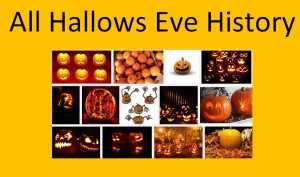All Hallows Eve History – Halloween night is just around the corner and with it comes the traditional trick-or-treating, but what does Halloween mean to you? To me it’s a fun time to just let loose and have fun, it’s also a time for me to steal my kids candy (don’t tell them that though). To other people though it is a devil worshiping day, and it has an evil background. To help put to rest the negativity that has surrounded this holiday, I decided to write a post about All Hallows Eve history.
History
At first All Hallows eve (October 31) was a day of feasting for Christians to commemorate the dead and to make fun of death itself. The holiday gets its roots from Celtic harvest festivals with pagan roots. Some Christian groups still practice some of the Holiday traditions: like lighting candles on the graves of relatives or attending church on Halloween night. It was titled All Hallows Eve because it was a day before the Christian holiday of All Hallows day (November 1), with All Souls day following (November 2). These three collective days were commonly titled All Hallows Tide and were used to commemorate and honor the long and recently passed souls.
All Hallows day was first celebrated in 609, but was originally celebrated on May 13th; the date was later switched to November 1 by request of Pope Gregory the 4th, no one knows the reason though. By the 12th century it became a popular tradition during All Hallows Tide to traverse the streets crying out and ringing a bell for the souls trapped in purgatory. It is thought that the origin of trick-or-treating came about by poor children going door-to-door asking for “soul cakes” in exchange for praying for their loved ones in purgatory.
The dressing up side of Halloween is thought to have come from the belief that spirits would haunt this world until all hallows night when they would get one last chance to get back at the people who wronged them. In order to prevent the ghosts from coming after them, people would dress in costume and wear masks to confuse the ghosts and make it out without trouble.
The tradition of All Hallows Tide and its meanings/customs came under scrutiny during the Reformation in the 1500s, where Protestants claimed that the notion of purgatory didn’t agree with the gospel and were therefore untrue. Therefore the belief was changed and it was decided that the spirits were actually demons. People started blessing their houses and barns in order to keep the evil creature away.
Pumpkin carving was originally started in Ireland and Scotland, but instead of using a pumpkin, they used a turnip. It wasn’t until 1837 when immigrants in American started carving native pumpkins because they were softer and larger, making them easier to carve.
Trick-or-treating didn’t become really popular until 1930, and it didn’t reach American soil until 1934. Originally people did souling, which is when people of the Catholic/Protestant church would go door to door asking for soul cakes in exchange for prayers for their loved ones.
Halloween didn’t originally come over with the settlers, this was due to its pagan roots and the Puritans thought it was an evil holiday, so they left the tradition behind them. It only started to spike in America when immigrants brought its traditions with them.
This once Christian holiday has come a long way. It’s most basic roots were a holiday in remembrance of their dead loved ones. Now it is either an evil holiday or a day to get free candy, some people may even still practice the original intention of the holiday. No matter what you think of it, it is still a holiday that can be enjoyed for a number of different reasons: Dressing up, free candy, the history aspect, etc. I enjoy it because it’s just plain fun.


Leave a Reply